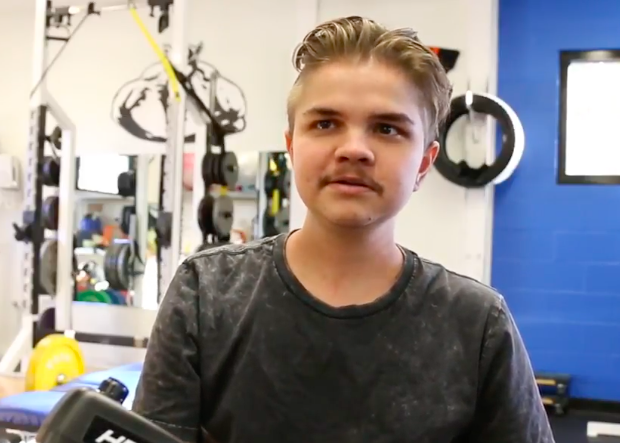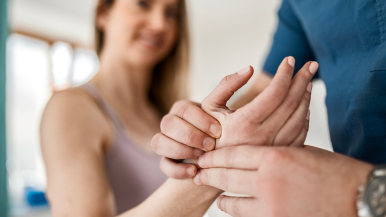Rehabilitation Program for Muscular Dystrophy Helps Patient Walk Again
 Dakota’s muscles had deteriorated to the point where he needed constant help at home and couldn’t perform the most routine activities without feeling exhausted. What’s worse, his physicians told him that he his chances for recovering normal functioning were practically nil. Refusing to accept the negative prognosis and taking matters into his own hands, Dakota turned to the team at Ability Rehabilitation.
Dakota’s muscles had deteriorated to the point where he needed constant help at home and couldn’t perform the most routine activities without feeling exhausted. What’s worse, his physicians told him that he his chances for recovering normal functioning were practically nil. Refusing to accept the negative prognosis and taking matters into his own hands, Dakota turned to the team at Ability Rehabilitation.
“I’ve been coming here for two years now,” says Dakota. “The biggest benefit is they’ve helped me learn how to walk again on my own and to be more independent at home.”
What Is Muscular Dystrophy?
Muscular dystrophy is a group of more than 30 hereditary and genetic diseases characterized by progressive weakness and loss of muscle mass. The muscle deterioration, which in some forms of the disease can affect the heart and other organs, is caused by genetic mutations that block the production of healthy proteins needed to grow healthy muscle.
Muscular dystrophy (MD) can manifest in many different forms, affect patients of different ages with varying degrees of symptoms and severity. Some types of MD only affect males. The five most common forms of muscular dystrophy include:
- Duchenne muscular dystrophy (DMD) – the most prevalent type of MD affecting almost half of all patients. It manifests only in males and appears between the ages of 2 and 6.
- Becker’s muscular dystrophy (BMD) – usually noticeable at adolescence.
- Myotonic muscular dystrophy – generally affects adults (men and women) between the ages of 20 to 30.
- Limb-girdle – appears in teens to early adulthood (males and females) and involves progressive weakness in the joints.
- Congenital muscular dystrophy (CMD) – noticeable at birth.
Dakota’s doctors gave him little hope of ever having a normal life. However, Dakota along with the therapists at Ability Rehabilitation refused to accept defeat. “The doctors said that I probably wouldn’t be able to walk again,” says Dakota. “(Ability Rehabilitation) helped me get to the point where I could walk again on my own. It was a struggle for a long time, but they helped me get my independence back.”
Symptoms of Muscular Dystrophy
Signs of muscle weakness can be seen by age 3, beginning in the hip, pelvic, thigh, and shoulder muscles, and later manifesting in the muscles of the arms, legs, and torso. By adolescence, the heart and breathing muscles can also be affected.
Common early symptoms of muscular dystrophy include:
- Waddling gait
- Muscle pain and stiffness
- Difficulty running and jumping
- Toe-walking
- Problems sitting up or standing
- Delayed speech
- Frequent falling
As the disease progresses, symptoms can include:
- Inability to walk
- Muscle and tendon shrinkage, further limiting movement
- Severe breathing problems requiring assisted breathing
- A curvature of the spine
- Cardiac issues
- Difficulty swallowing requiring a feeding tube
There are no cures for muscular dystrophy. Some gene therapies are currently being trialed to combat the disease.
Dakota’s disease had progressed to the point where he couldn’t get in the shower on his own. The simplest tasks such as getting food in the refrigerator made him exceedingly tired. “Sometimes muscular dystrophy takes a toll on your body,” says Dakota. “Just doing simple things makes you tired.”
Never Giving Up
Despite the odds and the adverse prognosis given by his doctors, Dakota persevered in his rehabilitation efforts, encouraged by the gradual yet consistent results he witnessed through his rehabilitation program.
“Before, I needed everyone to help me at home,” says Dakota. “Now I can get in the shower by myself. I can get food and get into bed by myself. It makes me feel like I can do stuff on my own.”
Dakota praises the Ability Rehabilitation staff for their support and care throughout his health journey. “Everybody here is really nice. They treat you like you’re family when you come here,” he says. “They make you feel like it’s your home. The people at the front desk always say hi to you every time you come in; they know your name. Everyone who works here is rooting for you to get back to your normal life.”
Grateful for the success of his rehabilitation journey, Dakota wishes for others to experience the same positive and life-enhancing results. “I would recommend anyone to come here and get help for an injury they had or who are just trying to get their strength back or anything like that,” he says.
To learn more about our rehabilitation services visit https://abilityrehabilitation.com/services/



